LARC’s commitment to developing standards-based, classroom ready curriculum and text in Less Commonly Taught Languages continues. The complete “Arabic Language through Dialogue” textbook series and online listening practice website is now complete. The “Iranian Panorama” series in Persian is not far behind, with a 1st edition of the elementary text expected by summer 2011. In Pashtu, a complete elementary text, with an accompanying alphabet book, picture dictionary, and grammar reference, is currently available. Intermediate and advanced level texts to extend the series are forthcoming. iPad / iPhone applications focused on alphabet and vocabulary acquisition are also under development for all 3 languages, as is an elementary textbook in Dari. Please see below to download PDF samples of some of these materials.
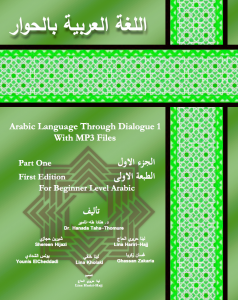
ARABIC LANGUAGE THROUGH DIALOGUE 1
By Dr Hanada Taha-Thomure, Lina Hariri, Shereen Hijazi, Ghassan Zakaria, Younis El Cheddadi and Lina Kholaki
This textbook is for total beginners in Arabic (high school and college level) who are interested in learning Arabic in a communicative, task-based way. The textbook quickly Arahelps the students to acquire knowledge of the Arabic letters and sounds and moves into using words and phrases that can be useful to them in everyday life situations from greetings, to introducing themselves, to explaining cultural nuances, to talking about their backgrounds and families. The textbook integrates all four language strands: speaking, listening, reading and writing. Many ideas and exercises are suggested for the teachers’ use. The textbook is in full color.
- MP3 Audio Files - ALTD 1
- View ALTD 1 on Montezuma Publishing website
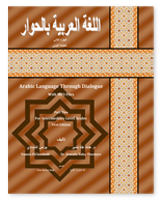
ARABIC LANGUAGE THROUGH DIALOGUE 2
By Dr. Hanada Taha-Thomure and Younis ElCheddadi
This book represents an attempt to build the Arabic learner’s communicative skills sequentially, in terms of vocabulary, grammar, and functional skills. It introduces the student to basic topics that are easily accessible and frequently used in everyday conversation, providing in each lesson a dialogue; speaking, reading, and writing exercises; cultural information; and selections from Arabic magazines and websites. The book focuses on developing spoken MSA skills as a way to enable the beginning student to communicate with speakers across a variety of dialects.
- MP3 Audio Files - ALTD 2
- View ALTD 2 on Montezuma Publishing website
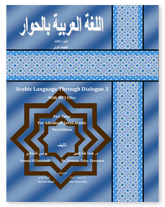
ARABIC LANGUAGE THROUGH DIALOGUE 3
By Dr. Hanada Taha-Thomure and Younis ElCheddadi
This textbook is for those students who have taken about 4 semesters of Arabic or who are at the Intermediate Mid level (ACTFL). Learning at this level remains communicative and rich in dialogues and exercises that are all related to the dialogue learned. Dialects are introduced again through songs from various parts of the Arab world. In addition, authentic stories from the Arab old tradition are introduced and learned. The textbook integrates all four language strands: speaking, listening, reading and writing. Many ideas and exercises are suggested for the teachers’ use. The textbook is in full color.
- MP3 Audio Files - ALTD 3
- View ALTD 3 on Montezuma Publishing website
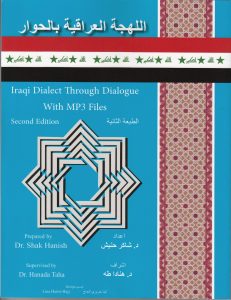
IRAQI DIALECT THROUGH DIALOGUE – ADVANCED
By Dr. Shak Hanish and Dr. Hanada Taha-Thomure
By Dr. Shak Hanishi and Dr. Hanada Taha-Thomure
The second edition of the Iraqi Dialect through Dialogue IraqiBook1 with MP3 book prepared by Shak Hanish and supervised by Dr. Hanada Taha was published by Montezuma Publishing that is affiliated with San Diego state University.
The book contains an introduction to Iraqi Arabic and with suggestions on using it for the instructors. The book contains 55 dialogues on various political, social, and historical subjects. Each dialogues starts with English introduction, dialogue, vocabulary, and discussion questions.
ISBN: 978-0-7442-3700-9
- MP3 Audio Files - Iraqi Dialect
- View Iraqi Dialect Through Dialogue on Montezuma Publishing website

Kharbashat 1 & 2 (with English translation)
By Dr Hanada Taha-Thomure
These are excerpts from the book"Kharbashat Imr'aa Arabiyyah" or "The scribbles of an Arab Woman". These poems are ideas, reflections and impressions of love, foreignness and life's detours written by Dr. Hanada Taha-Thomure. This version of the book only contains Arabic text. A bilingual version that will have English translation for each poem will soon be available.
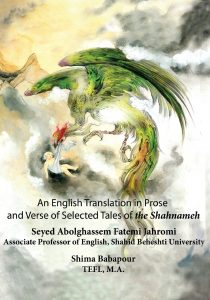
An English Translation in Prose and Verse of Selected Tales of the Shahnameh
By Seyed Abolghassem Fatemi Jahromi and Shima Babapour
The author's second book of Ferdowsi's eminent Persian poems is a new attempt to introduce his worthy masterpiece. The major parts of each tale have been scrutinized and translated into prose and verse. These stories manifest the deep knowledge, strong power of expression, unrivalled organization, and matchless beauty of the poems. Ferdowsi's deep knowledge, insight, and moral lessons are still alive even though the book was written more than a thousand years ago. Educational psychologists are still examining and studying the relationship among the characters of the tales, as it has affinity and similarities in the culture of the modern era.
The author has recorded the rhyming couplets in Persian for all 9 chapters of the book. Stay tuned as we make this available. It will contain the Persian text and recording, along with an English translation that can be revealed when the Persian text is clicked on.

IRANIAN PANORAMA 2
By Atefeh Oliai and Mani Motiee
Panorama 2 is the second book in the sequence of four textbooks from level 1 to 3+, each addressing on level of language proficiency according to the Interagency language roundtable (ILR) proficiency standards. The objective of Iranian Panorama 2 is to help students at the high Elementary level Persian to reach level 2 according to the ILR levels 1.
This book is organized into ten topics, each containing three lessons that introduce various aspects of the Iranian society. All materials are authentic: i.e. written for the usage of Iranian readers and not edited to tailor the pedagogy of the language. Activities, developed based on the communicative method, address all skills and follow the 5 “C’s” of the National Foreign Language Standards: Communication, Cultures, Connections, Comparisons, and Communities.
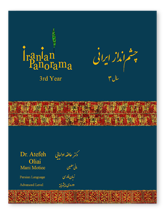
IRANIAN PANORAMA 3
By Atefeh Oliai and Mani Motiee
Iranian Panorama 3 is the third book in the sequence of four textbooks from level 1 to 3+, each addressing on level of language proficiency according to the interagency language roundtable (ILR) proficiency standards.
The objective of Iranian Panorama 3 is to help students at the high Elementary level Persian to reach level 2 according to the ILR levels.
All materials are authentic. Activities, developed based on the communicative method, address all skills and follow the 5 “C’s” of the National Foreign Language Standards.
Students will engage in individual, pair and group activities to improve their communication skills. Cultural activities will help students demonstrate an understanding of the practices and cultural products of members of the Iranian society.
The audio CD accompanying the book will help students to become familiar with the text.
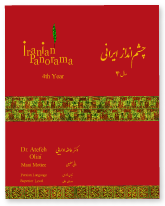
IRANIAN PANORAMA 4
By Atefeh Oliai and Mani Motiee
Panorama 4 is the last book in the sequence of four textbooks from level 1 to 3, each addressing a level of language proficiency according to the Interagency language roundtable ( ILR) proficiency standards. The objective of Iranian Panorama 4 is to help students at the high advanced level Persian to reach level 3 according to the ILR levels 1.
All materials used in this textbook, are authentic: i.e. written for the usage of Iranian readers and not edited to tailor the pedagogy of the language. Activities, developed based on the communicative method, address all skills and follow the 5 "C's" of the National Foreign Language Standards. Considerable written exercises address the realm of connection and communities in the 5Cs framework.
The audio CD accompanying the book will help students to become familiar with the text and conduct debates to help students improve their aural skill.
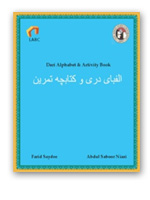
DARI ALPHABET & ACTIVITY BOOK
By Farid Saydee, and Abdul Saboor Niazi
This alphabet workbook has been prepared with the intention to teach Dari alphabet to interested individuals in an easy and fun way and within a short period of time. Students are expected to read and write Dari script after studying and completing the entire book with all its exercises. Dari letters are categorized into families of letters to facilitate learning except for the first letter of the alphabet. The letters in each family are introduced and their common characteristics are elaborated. Then, each letter is pronounced, transliterated and explained, backed with examples.
The examples in this book are of particular importance. Most of the examples are familiar words in English such as names of places written in Dari script.
The goal behind putting this book together is to enable students or enthusiasts of Dari language to, first of all, recognize and pronounce the letters in all their forms—whether connected or not to another letter, or used in the beginning, middle or at the end of a word. Second of all, students should be able to conjugate letters in a word and pronounce the words. Thirdly, students should be able to write when given simple words. In short, the goal of this book is threefold—to enable students’ recognition including pronunciation of letters, conjugation of letters to produce a word and writing of words as well as pronouncing them.
– View the Dari Alphabet and Activity Book on Montezuma Publishing website
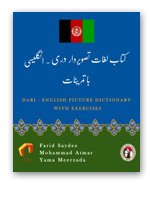
DARI – ENGLISH PICTURE DICTIONARY
By Farid Saydee, and Abdul Saboor Niazi
The Dari – English Picture Dictionary contains 13 thematic lessons related to the daily life. Each lesson has been developed based on the principles of "backward design and national standards." In other words, the lesson starts with introduction of 12-16 new vocabulary words and follows with guided activities for further memorization and retention. The listening activities, produced by native Dari speakers, further support learning of the contents to great extent. The lesson will end with an assessment activity.
- View the Dari - English Picture Dictionary on Montezuma Publishing website
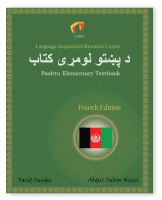
PASHTO ELEMENTARY TEXTBOOK
By Farid Saydee and Abdul Saboor Niazi
This Pashtu elementary level textbook has been designed based on the National Standards for Foreign Language Education which facilitates learning of Pashtu language in a short period of time. The textbook is learners‐friendly, supported by audio CD, and contains many interactive activities. The book has many grammatical expressions as well as three verb tenses (present, past and future). The book teaches Pashtu in all its forms that includes speaking, writing, reading and listening. The book is rich in content in all these major modes of communication.
After the successful completion of this book, students are expected to function at the Intermediate Low to Intermediate High level of ACTFL scale. ACTFL is the American Council on the Teaching of Foreign Languages.
- View the Pashto Elementary Textbook on Montezuma Publishing website
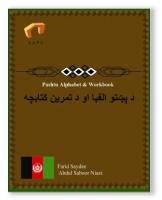
PASHTO ALPHABET BOOK
By Farid Saydee and Abdul Saboor Niazi
This alphabet workbook has been prepared with the intention to teach Pashto alphabet to interested individuals in an easy and fun way and within a short period of time. Students are expected to read and write Pashto script after studying and completing the entire book with all its exercises. Pashto letters are categorized into families of letters to facilitate learning except for the first letter of the alphabet. The letters in each family are introduced, their common characteristics are elaborated. Then, each letter is pronounced, transliterated and explained, backed with examples. The examples in this book are of particular importance. Most of the examples are familiar words in English such as names of places written in Pashto script.
The goal behind putting this book together is to enable students or enthusiasts of Pashto language to, first of all, recognize and pronounce the letters in all their forms whether connected or not to another letter, or used in the beginning, middle or at the end of a word. Second of all, students should be able to conjugate letters in a word and pronounce the words. Thirdly, students should be able to write when given simple words. In short, the goal of this book is threefold to enable student's recognition including pronunciation of letters, conjugation of letters to produce a word and writing of words as well as pronouncing them.
- View the Pashto Alphabet Book on Montezuma Publishing website
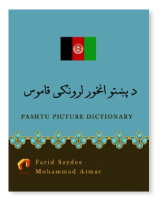
PASHTO PICTURE DICTIONARY
By Farid Saydee, Mohammad Atmar, and Yama Meerzadad
This is the first Pashto dictionary of its kind that teaches interested Pashto learners Pashto words through the use of pictures and interactive activities. The Pashto Picture Dictionary can be used independently or in conjunction with other teaching materials. Each lesson has been designed based on the National Standards and Backward Design. The authors are currently teaching Pashto classes at San Diego State University who have extensive knowledge in the area of teaching and curriculum development. An audio CD, produced by the native speakers in both -western and eastern- Pashto dialects, further supports the learning of the contents to great extent.
- View the Pashto Picture Dictionary on Montezuma Publishing website
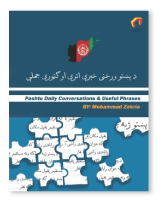
PASHTO PHRASE BOOK
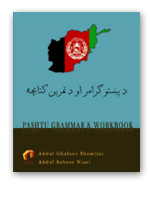
PASHTO GRAMMAR AND WORKBOOK
With audio files
By Mohammad Zekria
- View the Pashto Grammar and Workbook on Montezuma Publishing website
